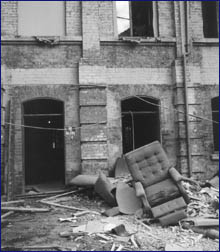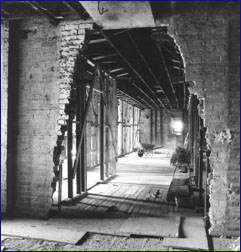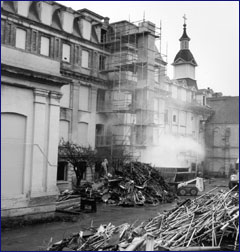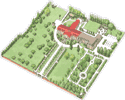Restoration
 |
 t.
Ann's Academy saw its last graduating class walk through the doors
in 1973. Facing rising operating costs and other difficulties, the
Sisters made the decision to close the school that year. The government
purchased the property; the grounds became parking, the gardens
grew over and the building served for a time as offices and board
rooms. Through much of the 1980s and early 1990s, the Academy was
closed, and suffered from dis-use, vandalism and water damage. It
was finally decided that the building would have to be demolished
or restored: they chose the second option. In 1993, Andrew Petter,
the Minister Responsible for the Provincial Capital Commission,
announced the re-development proposal for St. Ann's, at a cost of
$16.7 million. t.
Ann's Academy saw its last graduating class walk through the doors
in 1973. Facing rising operating costs and other difficulties, the
Sisters made the decision to close the school that year. The government
purchased the property; the grounds became parking, the gardens
grew over and the building served for a time as offices and board
rooms. Through much of the 1980s and early 1990s, the Academy was
closed, and suffered from dis-use, vandalism and water damage. It
was finally decided that the building would have to be demolished
or restored: they chose the second option. In 1993, Andrew Petter,
the Minister Responsible for the Provincial Capital Commission,
announced the re-development proposal for St. Ann's, at a cost of
$16.7 million.
The decision to restore the Academy drew proposals from many architects
and heritage planners, and Paul Merrick Architects Ltd. were chosen
after careful consideration. A long list of contractors, sub-contractors,
consultants and planners were involved in bringing the project to
light. Working with a large building with such a long history required
some compromises, and in order to create a self-financing situation,
it was decided that only the central entrance block from the 1886
addition, the chapel and the auditorium would be restored to their
historical appearance, while the rest of the structure would become
office space.
After researching, with the aid of old photographs, other historical
documents and scientific testing of paint layers and materials,
the era of the 1920's was chosen as the theme for the interior restoration.
Therefore, the colours, draperies, furniture and lighting in the
parlours, chapel and auditorium correspond to this time period.
On the third floor, one of the classrooms awaits similar treatment.
 The
structural engineers, Wayte Blohm and Associates, studied the structure
of the various phases of the St. Ann's building. Due to its masonry
or brick walls, built without reinforcement, which does not meet
current earthquake safety standards and is considered delicate,
a plan was developed to insert new concrete buildings inside the
existing walls of the Academy, in the Convent, 1871 and Hooper Wings.
This added a great deal of weight to the structure, which had originally
sat upon foundations set into soft clay. To balance this, a two
storey basement was excavated, essentially in the shape of a boat,
which "floats" on a steel- reinforced raft. In this manner,
the engineers could avoid underpinning the outer walls and disturbing
the rest of the structure. The
structural engineers, Wayte Blohm and Associates, studied the structure
of the various phases of the St. Ann's building. Due to its masonry
or brick walls, built without reinforcement, which does not meet
current earthquake safety standards and is considered delicate,
a plan was developed to insert new concrete buildings inside the
existing walls of the Academy, in the Convent, 1871 and Hooper Wings.
This added a great deal of weight to the structure, which had originally
sat upon foundations set into soft clay. To balance this, a two
storey basement was excavated, essentially in the shape of a boat,
which "floats" on a steel- reinforced raft. In this manner,
the engineers could avoid underpinning the outer walls and disturbing
the rest of the structure.
The exterior of St. Ann's was not altered after the addition of
the 1910 wing, with the exception of the replacement of the central
wooden staircase with concrete. The exterior restoration involved
repairs rather than alterations. All of the damaged parts, including
the cornices (the decorative segments at the top of the building),
the roof, the chimney, the bell tower, the plaster moldings and
the window glass and frames, were replaced and the paint was stripped.
The building was then repainted in the original colour.
The gardens have become the focus since the completion of the building.
Although the older trees in the orchard and the arboretum are not
being replaced, much of the smaller flora, including the herbs in
the Novitiate's Garden, have been researched and re-planted. It
is the intention that the community will enjoy the paths winding
through the gardens, and that there will soon be a direct connection
through to Beacon Hill Park, to the south side of the Academy grounds.
The restoration project continues in many aspects today. It is the
intention that this site will eventually expand to include a broader
discussion of the restoration.
John Taylor
 John
Taylor, of John Taylor Photography, became the site photographer
for the restoration project. Interested in documenting the process
of restoring St. Ann's, he began in late December, 1995. Taylor
attempted to capture the layers of the building in an artistic manner.
Initially focusing on the architecture and the grounds, he soon
realized that the tradespeople were part of the restoration and
that their work could add another dimension to the photographs.
Experimenting with low light conditions and finding an aesthetic
appreciation for what, at first, had appeared to be simply a decaying
building, he worked mostly in black and white Ilford Delta high
speed films. John Taylor would like to see his photographs used
within the restored building as a reference to what happened during
the restoration process and his beautifully composed images of St.
Ann's can be seen throughout this web site, whenever the restoration
is discussed. John
Taylor, of John Taylor Photography, became the site photographer
for the restoration project. Interested in documenting the process
of restoring St. Ann's, he began in late December, 1995. Taylor
attempted to capture the layers of the building in an artistic manner.
Initially focusing on the architecture and the grounds, he soon
realized that the tradespeople were part of the restoration and
that their work could add another dimension to the photographs.
Experimenting with low light conditions and finding an aesthetic
appreciation for what, at first, had appeared to be simply a decaying
building, he worked mostly in black and white Ilford Delta high
speed films. John Taylor would like to see his photographs used
within the restored building as a reference to what happened during
the restoration process and his beautifully composed images of St.
Ann's can be seen throughout this web site, whenever the restoration
is discussed.
|



 The
structural engineers, Wayte Blohm and Associates, studied the structure
of the various phases of the St. Ann's building. Due to its masonry
or brick walls, built without reinforcement, which does not meet
current earthquake safety standards and is considered delicate,
a plan was developed to insert new concrete buildings inside the
existing walls of the Academy, in the Convent, 1871 and Hooper Wings.
This added a great deal of weight to the structure, which had originally
sat upon foundations set into soft clay. To balance this, a two
storey basement was excavated, essentially in the shape of a boat,
which "floats" on a steel- reinforced raft. In this manner,
the engineers could avoid underpinning the outer walls and disturbing
the rest of the structure.
The
structural engineers, Wayte Blohm and Associates, studied the structure
of the various phases of the St. Ann's building. Due to its masonry
or brick walls, built without reinforcement, which does not meet
current earthquake safety standards and is considered delicate,
a plan was developed to insert new concrete buildings inside the
existing walls of the Academy, in the Convent, 1871 and Hooper Wings.
This added a great deal of weight to the structure, which had originally
sat upon foundations set into soft clay. To balance this, a two
storey basement was excavated, essentially in the shape of a boat,
which "floats" on a steel- reinforced raft. In this manner,
the engineers could avoid underpinning the outer walls and disturbing
the rest of the structure. John
Taylor, of John Taylor Photography, became the site photographer
for the restoration project. Interested in documenting the process
of restoring St. Ann's, he began in late December, 1995. Taylor
attempted to capture the layers of the building in an artistic manner.
Initially focusing on the architecture and the grounds, he soon
realized that the tradespeople were part of the restoration and
that their work could add another dimension to the photographs.
Experimenting with low light conditions and finding an aesthetic
appreciation for what, at first, had appeared to be simply a decaying
building, he worked mostly in black and white Ilford Delta high
speed films. John Taylor would like to see his photographs used
within the restored building as a reference to what happened during
the restoration process and his beautifully composed images of St.
Ann's can be seen throughout this web site, whenever the restoration
is discussed.
John
Taylor, of John Taylor Photography, became the site photographer
for the restoration project. Interested in documenting the process
of restoring St. Ann's, he began in late December, 1995. Taylor
attempted to capture the layers of the building in an artistic manner.
Initially focusing on the architecture and the grounds, he soon
realized that the tradespeople were part of the restoration and
that their work could add another dimension to the photographs.
Experimenting with low light conditions and finding an aesthetic
appreciation for what, at first, had appeared to be simply a decaying
building, he worked mostly in black and white Ilford Delta high
speed films. John Taylor would like to see his photographs used
within the restored building as a reference to what happened during
the restoration process and his beautifully composed images of St.
Ann's can be seen throughout this web site, whenever the restoration
is discussed.